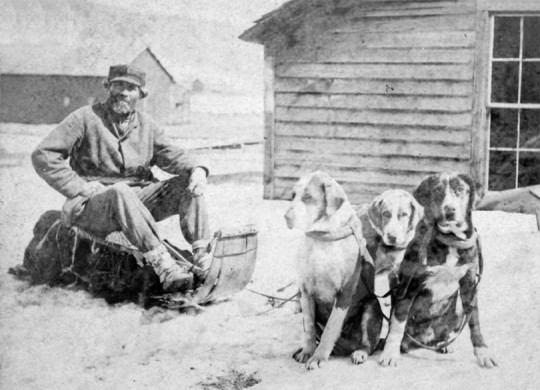LEGEND OF JOHN BEARGREASE

Since 1980, the John Beargrease Sled Dog Marathon has attracted mushers from around the world. Beginning in Duluth and running 400 miles along the north shore of Lake Superior to the Canadian border, the Beargrease is one of the longest, most grueling race routes outside of Alaska. With the 30th running of the marathon starting later this month, many people are asking “Who is John Beargrease” and Why does he have a sled dog race named after him?”.
John Beargreas’s story began in a wigwam on the outskirts of the first settlement along the north shore of Lake Superior, Beaver Bay. The son of an Anishinabe Chief, Beargrease grew up fishing, hunting, and trapping along the north shore with his father and two brothers. When he was in his teens he worked on commercial fishing boats that sailed up and down the coastline. By the time he was in his twenties, a few more small settlements had sprung up along the north shore, including Agate Bay [now Two Harbors], Castle Danger, Pork Bay, Grand Marais, and Grand Portage. Since the train only went as far as Agate Bay, people along the shore had a hard time sending and receiving mail. Since this was often the only form of communication with the outside world.
Letters and packages from family and friends were extremely important. Since Beargrease and his brothers made regular trips up and down the shore trapping and trading, they began to grab the mail in Agate Bay for the residents along the shore and deliver it as they checked their traps or traded with other residents. By 1879, the brothers were making trips for the mail and delivering it all the way to Grand Marais once or twice per week.
Over the next twenty years, Beargrease was a welcome sight for people living along the north shore. They would eagerly await his arrival each week. He not only delivered mail from their loved ones, he also brought local and national news, weather reports from up and down the shore, and for some- a little company. Beargrease would make his route year ’round in all types of weather. In the warmer months he would deliver the mail by canoe or boat, but he was best known for his winter travels by dogsled. he made his fastest dogsled trip from Agate Bay to Grand Marais with a load of about 700 lbs. of mail in just under 28 hours. In the summer, he could make the same trip by boat in about 20 hours.
John Beargrease made his last mail delivery on April 26, 1899. By that time, the trail he traveled for over twenty years had become a well-used road. He made his last delivery using a horse and buggy instead of a canoe or dogsled. Beargrease continued his successful trading business along the north shore, making his home in Beaver Bay and among his people in Grand Portage. One day in 1910, he went out in a storm to rescue a mail carrier whose boat was caught in the waves of tamarack Point, near Grand Portage. He caught pneumonia after the ordeal and died soon after. His grave can be seen today at the Indian Cemetery in Beaver Bay.
Because of his reliable and successful mail delivery, the population along the north shore grew and the economy stabilized. Small settlements grew into permanent towns with residents who continue to recognize the role John Beargrease played in their history. Forgotten Minnesota.
Recent Comments